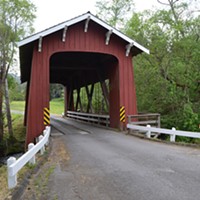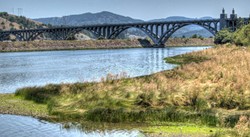[
{
"name": "Top Stories Video Pair",
"insertPoint": "7",
"component": "17087298",
"parentWrapperClass": "fdn-ads-inline-content-block",
"requiredCountToDisplay": "1"
}
]
The trick of combining the tensile strength (resistance to pulling) of iron and steel with the compressive strength (resistance to pushing) of concrete is just 160 years old. In 1853, French industrialist François Coignet built an iron-reinforced concrete four-story house in Paris. Then 50 years later, another Frenchman, Eugène Freyssinet (1879-1962), took the technique to the next level with his prestressed concrete arch bridge designs. The first use of Freyssinet's technique in the United States is a seven-arch reinforced concrete bridge on Highway 101 just a few hours north of here: the Isaac Lee Patterson Memorial bridge crossing the Rogue River between Gold Beach and Wedderburn, Ore.
While engineers can design concrete to resist huge compressive forces — up to 5 tons per square inch — they also go to great lengths to avoid putting concrete in tension, since it cracks very easily. However, French engineers (must be the wine over there) realized in the 1880s that a concrete beam, for instance, can be kept in a permanent state of compression by "prestressing" it: clamping the concrete tightly by stretching steel rods or cables between the ends of the beam. Freyssinet's lasting contribution was to apply the prestressing technique to concrete arch bridges, which were known to deform after construction due to the twin effects of concrete "creep" and steel "relaxation."
Freyssinet perfected his arch precompression technique during construction of a series of bridges in France, starting in 1911 with the Pont du Veurdre, in the Auvergne. At the time, the three 238-foot spans were the longest in the world. Conde McCullough, Oregon state bridge engineer from 1919 to 1936, knew of Freyssinet's pioneering designs when he was directed to design a bridge across the Rogue in 1929. He not only used Freyssinet's techniques, but he arranged for the state of Oregon to buy 16 250-metric-ton hydraulic screw jacks from Freyssinet's firm in Paris to be used in the construction.
Once the concrete abutments and piers had been installed, the contractor — Eureka's own Mercer-Fraser — built timber falsework (temporary scaffolding) to support the seven arches. Instead of joining the reinforced concrete arches at their crowns (the usual method up until then), the tops of the arches were kept slightly separate. The jacks were then installed between the ends to pry them apart, raising them slightly in the process. Workers poured high-strength concrete between the two half-spans to act as a keystone. Once the concrete had set and steel rebar was welded into place to create a solid connection, they removed the falsework. Eventually the bridge settled under its own weight to its design profile (see diagram).
The bridge was built (under budget!) in just two years, from 1930 to 1932. This is an astonishingly short period, considering that new techniques were being used for the first time in the United States, and that the nearest railway line was 80 miles away. Next time you're in Gold Beach, do walk the short trail upstream from the jet boat docks to a viewpoint just past the bridge. From there, you can admire the Art Deco lines and slender arches of Oregon's most elegant bridge, made possible by the pioneering techniques of Eugène Freyssinet. •
Barry Evans ([email protected]) is happy to report that all his bridges from his civil engineering days are still standing — to the best of his knowledge.
Speaking of...
-

Bridging the Divide
May 9, 2013 - More »
more from the author
-
Doubting Shakespeare, Part 1: Stratfordians vs. anti-Stratfordians
- Apr 25, 2024
-
A Brief History of Dildos
- Apr 11, 2024
-
Eclipse!
- Mar 28, 2024
- More »
Latest in Field Notes
Readers also liked…
-
Trouble on the Line: The Reality Part 2
- Nov 3, 2022

































